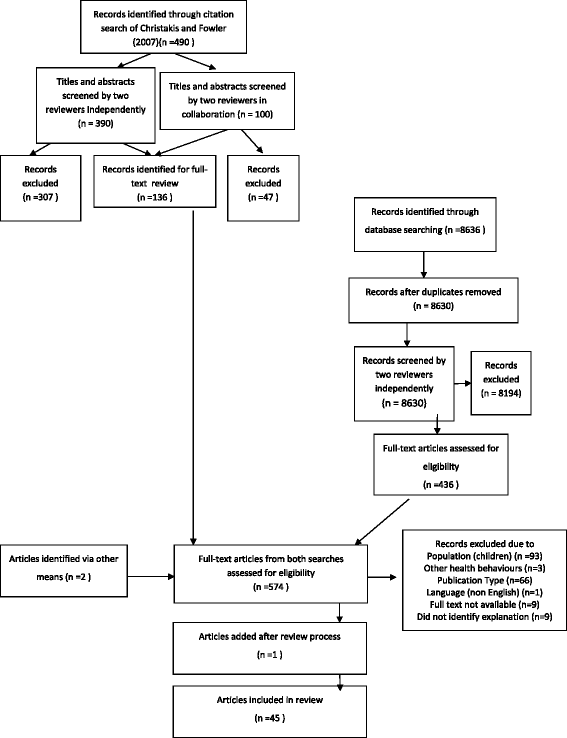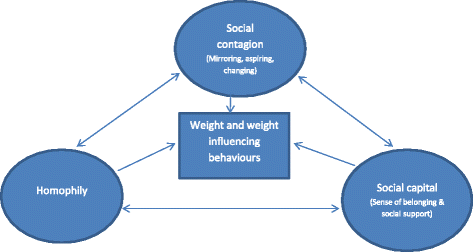The role of social networks in the development of overweight and obesity among adults: a scoping review
- PMID: 26423051
- PMCID: PMC4589958
- DOI: 10.1186/s12889-015-2314-0
The role of social networks in the development of overweight and obesity among adults: a scoping review
Abstract
Background: Although it is increasingly acknowledged that social networks are important to our understanding ofoverweight and obesity, there is limited understanding about the processes by which such networks shapetheir progression. This paper reports the findings of a scoping review of the literature that sought to identify the key processes through which social networks are understood to influence the development of overweight and obesity.
Methods: A scoping review was conducted. Forty five papers were included in the final review, the findings of which were synthesised to provide an overview of the main processes through which networks have been understood to influence the development of overweight and obesity.
Results: Included papers addressed a wide range of research questions framed around six types of networks: a paired network (one's spouse or intimate partner); friends and family (including work colleagues and people within social clubs); ephemeral networks in shared public spaces (such as fellow shoppers in a supermarket or diners in a restaurant); people living within the same geographical region; peers (including co-workers, fellow students, fellow participants in a weight loss programme); and cultural groups (often related toethnicity). As individuals are embedded in many of these different types of social networks at any one time, the pathways of influence from social networks to the development of patterns of overweight and obesity are likely to be complex and interrelated. Included papers addressed a diverse set of issues: body weight trends over time; body size norms or preferences; weight loss and management; physical activity patterns; and dietary patterns.
Discussion: Three inter-related processes were identified: social contagion (whereby the network in which people are embedded influences their weight or weight influencing behaviours), social capital (whereby sense of belonging and social support influence weight or weight influencing behaviours), and social selection (whereby a person's network might develop according to his or her weight).
Conclusions: The findings have important implications for understanding about methods to target the spread of obesity, indicating that much greater attention needs to be paid to the social context in which people make decisions about their weight and weight influencing behaviours.
Figures
References
-
- Smith KP, Christakis NA. Social networks and health. Annu Rev Sociol. 2008;34:405–29. doi: 10.1146/annurev.soc.34.040507.134601. - DOI
-
- Elias N. The civilising process: the history of manners and state formation and civilization. Oxford: Blackwell; 1994.
-
- Apolloni A, Marathe A, Pan ZZ. A Longitudinal View of the Relationship Between Social Marginalization and Obesity. 2011;61–8 p
-
- Franzini L, Taylor W, Elliott MN, Cuccaro P, Tortolero SR, Janice Gilliland M, et al. Neighborhood characteristics favorable to outdoor physical activity: Disparities by socioeconomic and racial/ethnic composition. Health Place. 2010;16(2):267–74. doi: 10.1016/j.healthplace.2009.10.009. - DOI - PubMed
Publication types
MeSH terms
LinkOut - more resources
Full Text Sources
Other Literature Sources
Medical
Research Materials



